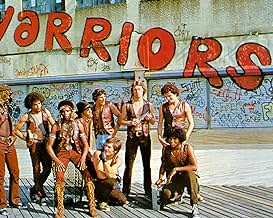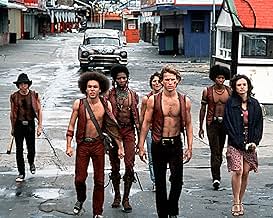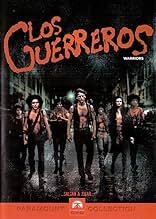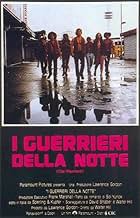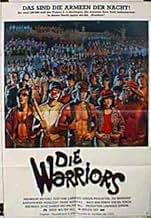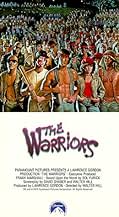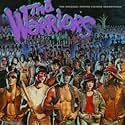रात के फौजियों की संख्या 1,00,000 है और वे पुलिस की संख्या से पांच गुना ज्यादा हैं; और आज रात वे वारियर्स पर हमला करेंगे।रात के फौजियों की संख्या 1,00,000 है और वे पुलिस की संख्या से पांच गुना ज्यादा हैं; और आज रात वे वारियर्स पर हमला करेंगे।रात के फौजियों की संख्या 1,00,000 है और वे पुलिस की संख्या से पांच गुना ज्यादा हैं; और आज रात वे वारियर्स पर हमला करेंगे।
Marcelino Sánchez
- Rembrandt
- (as Marcelino Sanchez)
कहानी
क्या आपको पता है
- ट्रिवियाSol Yurick wrote the original book as a rebuttal to the romanticized view of street gangs presented in West Side Story (1961) based on his experience as a New York City welfare department worker.
- गूफ़Fox is thrown onto the tracks and presumably killed when the train comes at him in the 96th Street station. When Swan and Mercy come back together, they go down to the tracks at the 96th Street station. There would be police and other crews all over the station had someone been killed on the tracks just a short while ago, but the station is empty except for one lone passenger.
- क्रेज़ी क्रेडिटIn the original version, the end credits are followed by 3 minutes of black screen as the Joe Walsh song "In the City" plays.
- इसके अलावा अन्य वर्जनThe Ultimate Director's Cut runs around one minute longer, adding a voiceover introduction from director Walter Hill describing a legendary Greek army's attempt to fight its way home, and comic-book freeze frame shots bridging various scenes in the film.
फीचर्ड रिव्यू
There are numerous reasons why Walter Hill's THE WARRIORS remains a classic film - and arguably not simply a cult classic, but a true classic - despite its very much of-its-time sensibilities. Somewhat ironically, the movie's acting is not among those reasons. With the exception of two bravura efforts by Roger Hill and David Patrick Kelly, one will not find "command performances" here (although James Remar and Deborah Van Valkenburgh do gnaw quite a bit on the scenery). Other than that, the acting is hard-boiled and generic. But then, the lack of flair in the acting department is arguably one of the film's unsung strengths. As the main protagonist, for example, Michael Beck, while not exactly sympathetic, is an easily relatable hero. He's very much like Henry Fonda in 12 ANGRY MEN - except, of course, for the long hair and the bare chest.
Much more remarkable are all the ways in which THE WARRIORS managed to create a thrilling cinematic experience that still holds up today, despite its low budget. The list is a long one: set design (such as it is), dialogue, music, costume design, makeup, thematic elements. But most worthy of mention is Andrew Laszlo's cinematography. I love the camera's aesthetic, which is very "1970s" but, in a number of ways, is more compelling than any filmic style you'll see today. It is rooted in realism, but the "reality" it depicts is clearly a "heightened" variety, as we see the dark New York City streets illuminated as if by nighttime stage lights. And the outlandish goings-on seen throughout much of the film compound the surreal atmosphere. The end result is wonderfully paradoxical: it is an awe-inspiring experience to imagine that the fantastical events depicted could actually be happening, or once did happen.
But the "look" of this film would be insignificant without a strong story and solid thematic content, and THE WARRIORS possesses these in spades. It is remembered, somewhat condescendingly, as a "typical" late '70s film, but I think it is more accurate to think of it as a '60s film made a full decade too late. It is, after all, adapted from Sol Yurick's 1965 novel of the same name (and its tagline, "These are the armies of the night," obviously echoes the title of Norman Mailer's 1968 novel). More to the point, the movie's premise of a gangland insurrection contains quite a few overtones and undertones of political radicalism, and visual reminders of the '60s counterculture are not uncommon. (It is interesting to note that the original novel was inspired in part by Xenophon's 4th century B. C. epic ANABASIS, so the film also offers allusions to Greek myth and legend for those who care to look for them.)
But there is so much more in THE WARRIORS to capture the imagination. The movie's soundtrack - an assortment of disco, hard rock, and early synthpop, plus a few would-be radio hits - is rightly famous, as is its carnivalesque depiction of inner-city life (an influence on the Insane Clown Posse's "Dark Carnival" mythology, perhaps?). The action sequences, too, are first-rate - intense and thrilling. (Given that the cops who are looking for the Warriors are no less silently menacing than the rival gang members out for revenge, the mood of suspense is non-stop.) And few films have captured the frustration and tedium of making one's way through New York City's countless neighborhoods more effectively than this one.
It is unfortunate that THE WARRIORS will probably never be taken completely seriously by film critics and historians, in part because of the campy 2005 video game adaptation released in its "honor" (which I have played, and which is undeniably addictive and a hell of a lot of fun). But all those who are able to peer beyond the lens of the "cult" prejudice will be able to appreciate both Walter Hill's cinematic genius and his penchant for visual pizazz. From the opening image of a lit-up Ferris wheel - both innocent and eerie - to the final shot of a carefree romp along Coney Island's beach, THE WARRIORS is unforgettable.
Much more remarkable are all the ways in which THE WARRIORS managed to create a thrilling cinematic experience that still holds up today, despite its low budget. The list is a long one: set design (such as it is), dialogue, music, costume design, makeup, thematic elements. But most worthy of mention is Andrew Laszlo's cinematography. I love the camera's aesthetic, which is very "1970s" but, in a number of ways, is more compelling than any filmic style you'll see today. It is rooted in realism, but the "reality" it depicts is clearly a "heightened" variety, as we see the dark New York City streets illuminated as if by nighttime stage lights. And the outlandish goings-on seen throughout much of the film compound the surreal atmosphere. The end result is wonderfully paradoxical: it is an awe-inspiring experience to imagine that the fantastical events depicted could actually be happening, or once did happen.
But the "look" of this film would be insignificant without a strong story and solid thematic content, and THE WARRIORS possesses these in spades. It is remembered, somewhat condescendingly, as a "typical" late '70s film, but I think it is more accurate to think of it as a '60s film made a full decade too late. It is, after all, adapted from Sol Yurick's 1965 novel of the same name (and its tagline, "These are the armies of the night," obviously echoes the title of Norman Mailer's 1968 novel). More to the point, the movie's premise of a gangland insurrection contains quite a few overtones and undertones of political radicalism, and visual reminders of the '60s counterculture are not uncommon. (It is interesting to note that the original novel was inspired in part by Xenophon's 4th century B. C. epic ANABASIS, so the film also offers allusions to Greek myth and legend for those who care to look for them.)
But there is so much more in THE WARRIORS to capture the imagination. The movie's soundtrack - an assortment of disco, hard rock, and early synthpop, plus a few would-be radio hits - is rightly famous, as is its carnivalesque depiction of inner-city life (an influence on the Insane Clown Posse's "Dark Carnival" mythology, perhaps?). The action sequences, too, are first-rate - intense and thrilling. (Given that the cops who are looking for the Warriors are no less silently menacing than the rival gang members out for revenge, the mood of suspense is non-stop.) And few films have captured the frustration and tedium of making one's way through New York City's countless neighborhoods more effectively than this one.
It is unfortunate that THE WARRIORS will probably never be taken completely seriously by film critics and historians, in part because of the campy 2005 video game adaptation released in its "honor" (which I have played, and which is undeniably addictive and a hell of a lot of fun). But all those who are able to peer beyond the lens of the "cult" prejudice will be able to appreciate both Walter Hill's cinematic genius and his penchant for visual pizazz. From the opening image of a lit-up Ferris wheel - both innocent and eerie - to the final shot of a carefree romp along Coney Island's beach, THE WARRIORS is unforgettable.
- marcusman48
- 21 अग॰ 2022
- परमालिंक
टॉप पसंद
रेटिंग देने के लिए साइन-इन करें और वैयक्तिकृत सुझावों के लिए वॉचलिस्ट करें
विवरण
बॉक्स ऑफ़िस
- बजट
- $40,00,000(अनुमानित)
- US और कनाडा में सकल
- $2,24,90,039
- US और कनाडा में पहले सप्ताह में कुल कमाई
- $35,29,675
- 11 फ़र॰ 1979
- दुनिया भर में सकल
- $2,24,95,288
इस पेज में योगदान दें
किसी बदलाव का सुझाव दें या अनुपलब्ध कॉन्टेंट जोड़ें





